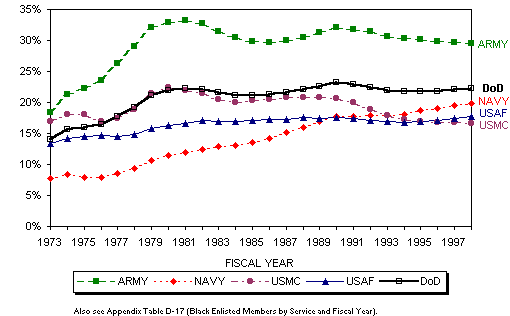|
Race/Ethnicity. The military attracts and
retains higher proportions of Blacks and "Other" minority groups but lower proportions of Hispanics than are in the civilian labor force. As Table 3.3 indicates, the overall proportion of enlisted
minorities was higher than in the civilian labor force in FY 1998 (36 and 30 percent, respectively). While Hispanics were underrepresented among enlisted members (8 percent versus 13 percent), the Services have
made gains since 1987, when only 4 percent of the enlisted force was Hispanic.
Table 3.3. FY 1998 Race/Ethnicity of Active Component Enlisted Members,
by Service, and Civilian Labor Force 18–44 Years Old (Percent) |
Race/
Ethnicity |
Army |
Navy |
Marine Corps |
Air Force |
DoD |
18- to 44-Year-Old Civilians |
| White |
56.3 |
63.2 |
66.6 |
73.0 |
63.7 |
70.5 |
| Black |
29.5 |
19.9 |
16.6 |
17.8 |
22.2 |
12.3 |
| Hispanic |
7.6 |
9.0 |
12.3 |
5.1 |
8.0 |
12.5 |
| Other |
6.6 |
7.9 |
4.5 |
4.2 |
6.1 |
4.7 |
| Total
|
100.0 |
100.0 |
100.0 |
100.0 |
100.0 |
100.0 |
Columns may not add to total due to rounding.
Also see Appendix Table B-25 (Race/Ethnicity by Service and Gender).
Source: Civilian data from Bureau of Labor Statistics Current Population Survey File, September 1998. |
Twenty-two percent of the enlisted force was Black, compared with 12 percent of
the civilian labor force (18–44 year-olds). This near 2:1 ratio for Black members was higher than for FY 1998 accessions, primarily because retention was higher among
Blacks than Whites. The Army had the highest proportion of Black enlisted members in FY 1998 (30 percent).Changes over time in the percentage of Black enlisted members in each Service are
shown in Figure 3.3. Black soldiers in the Army increased from 18 percent in FY 1973 to a high of 33 percent in FY 1981. That proportion decreased to 30 percent
by the mid-1980s, in large part due to an increase in entrance standards and the Army's decision not to renew enlistment contracts of low-scoring members who
entered during the ASVAB misnorming. The proportion of Blacks in the Army has remained stable since FY 1993 at 30 percent.
 |
Figure 3.3. Blacks as a percentage of Active Component enlisted members, by Service, FYs 1973–1998.The Marine Corps has experienced slight decreases in Blacks during recent years,
paralleling the drop in minority accessions in FY 1991 and the concomitant decrease in the propensity to enlist among Black youth. Black male propensity declined 19 percentage points between 1991 and 1998.(2) The Navy, on the other hand,
exhibited a consistent long-term increase in the proportion of Blacks, from 8 percent in FY 1973 to 20 percent in FY 1998. In all Services, the percentage of female
members who are Black significantly exceeds the percentage of male members who are Black (Appendix Table B-25).In FY 1998, active duty Hispanic enlisted members were a smaller part of the enlisted
force than of the civilian labor force in the 18–44 age group (8 percent and 12 percent, respectively). The highest representation of Hispanics was in the Marine
Corps (12 percent). The proportions of "Other" minority individuals in the Army and Navy were similar (7 and 8 percent, respectively), while the Marine Corps and Air
Force had somewhat less (5 and 4 percent, respectively).
 Go to next
. Go to next
.
|